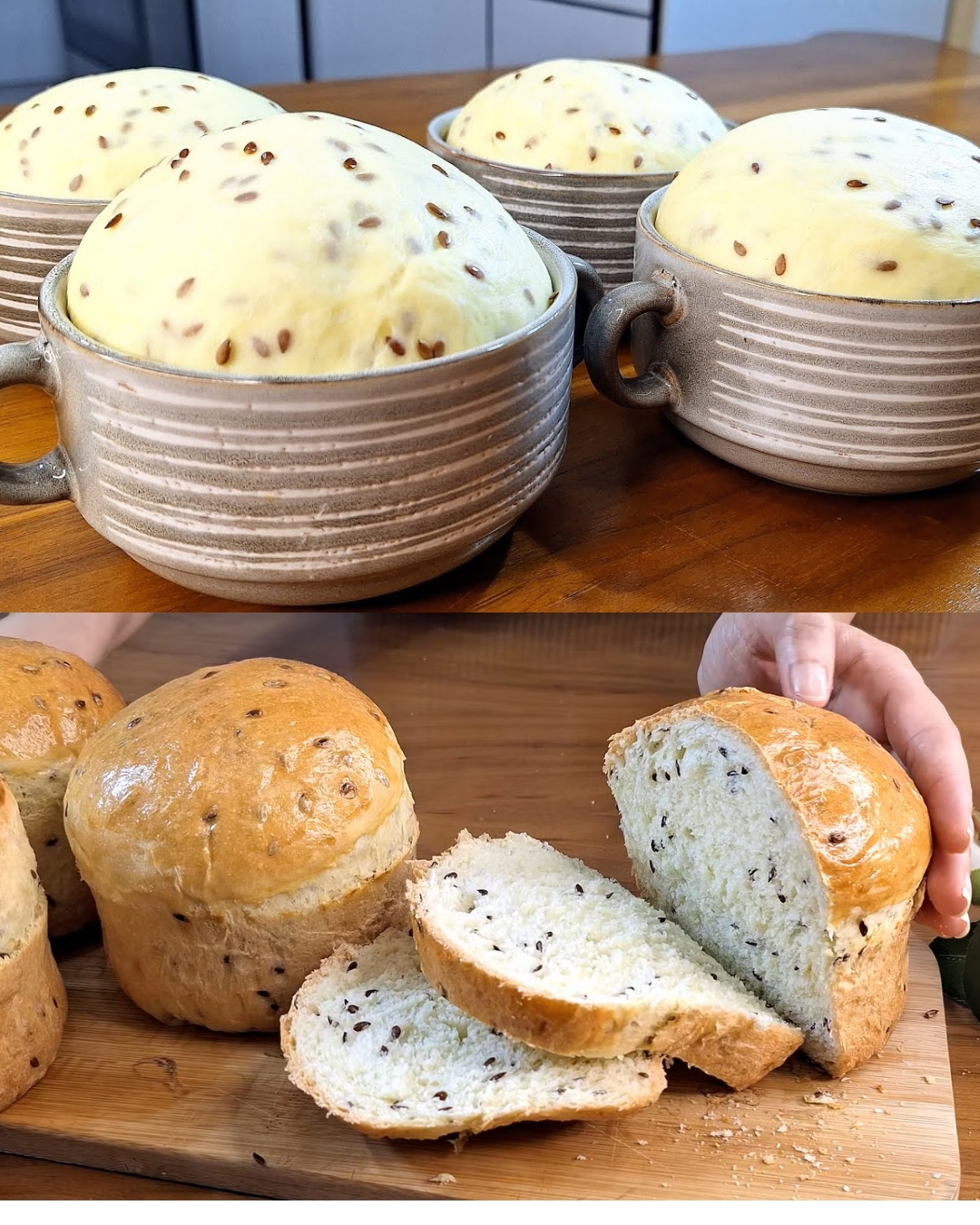This recipe yields a soft and flavorful flaxseed bread, perfect for sandwiches, toast, or enjoying on its own. The addition of flax seeds adds a nutty flavor and nutritional boost, while the soft butter crust enhances its richness. The rising times ensure a light and airy texture.
Preparation Time: 20 minutes
- This includes preparing the yeast mixture, mixing dry and wet ingredients, and kneading the dough.
Cook Time: 30 minutes
- This includes the second rise and baking time.
Total Time: 2 hours (including rising time)
- This includes all preparation, rising, and cooking time.
Ingredients:
- 500 grams sifted all-purpose flour
- 2 tablespoons flax seeds
- 1 teaspoon salt
- 8 grams dry yeast (about 2 ¼ teaspoons)
- 2 tablespoons granulated sugar (divided)
- 350 ml warm milk (divided)
- 1 teaspoon baking powder
- 1 tablespoon apple cider vinegar
- 1 large egg
- 25 ml sunflower oil (about 2 tablespoons)
- 50 grams softened butter (for brushing)
Directions:
-
Prepare the Yeast Mixture:
- In a small bowl, combine the dry yeast with 1 tablespoon of the granulated sugar and half of the warm milk (about 175 ml).
- Gently stir the mixture and let it sit for about 10 minutes, or until it becomes frothy. This indicates that the yeast is active.
-
Mix Dry Ingredients:
- In a large mixing bowl, sift the flour to ensure a light and airy texture.
- Add the flax seeds, salt, and baking powder to the sifted flour.
- Whisk the dry ingredients together to combine them evenly.
-
Combine Wet Ingredients:
- In another bowl, whisk together the remaining warm milk (about 175 ml), apple cider vinegar, egg, sunflower oil, and the remaining 1 tablespoon of granulated sugar.
- Whisk until all the wet ingredients are well combined.
-
Form the Dough:
- Pour the wet ingredients into the dry ingredients.
- Mix with a spoon or spatula until the ingredients are mostly combined.
- Add the frothy yeast mixture to the dough.
- Continue mixing until a shaggy dough forms.
-
Knead the Dough:
- Lightly flour a clean surface.
- Turn the dough out onto the floured surface.
- Knead the dough for about 10 minutes, or until it becomes smooth and elastic.
- If the dough is too sticky, add a little more flour, one tablespoon at a time.
-
First Rise:
- Lightly grease a large bowl with oil or butter.
- Place the kneaded dough in the greased bowl.
- Cover the bowl with a damp cloth or plastic wrap.
- Place the bowl in a warm, draft-free place and let the dough rise for about 1 hour, or until it has doubled in size.
-
Shape the Dough:
- Once the dough has doubled, punch it down gently to release the air.
- Turn the dough out onto a lightly floured surface.
- Knead it briefly to redistribute the air.
- Shape the dough into a loaf or divide it into smaller portions to make individual rolls.
- For a loaf, shape the dough into a rectangle and roll it up tightly.
- Place the shaped dough into a greased loaf pan or on a baking sheet lined with parchment paper.
-
Second Rise:
- Cover the shaped dough again with a damp cloth or plastic wrap.
- Let it rise for another 30 minutes in a warm place.
-
Preheat the Oven:
- Preheat your oven to 180 degrees Celsius (350 degrees Fahrenheit).
-
Bake the Bread:
- Before placing the bread in the oven, brush the top of the dough with the softened butter. This will create a soft, buttery crust.
- Bake the bread in the preheated oven for 25-30 minutes, or until the top is golden brown and the bread sounds hollow when tapped on the bottom.
-
Cool the Bread:
- Remove the bread from the oven and carefully transfer it to a wire rack to cool completely.
- Let the bread cool before slicing to prevent it from becoming gummy.
Nutritional Facts (Approximate per serving, based on 12 servings):
- Calories: 200-250
- Protein: 7-9g
- Fat: 6-8g
- Carbohydrates: 30-35g
- Fiber: 3-4g
The Origins and Popularity of This Recipe:
Homemade bread has been a staple in many cultures for centuries. Flaxseed bread, in particular, has gained popularity due to its nutritional benefits and unique flavor. The use of flax seeds adds omega-3 fatty acids, fiber, and lignans, making it a healthy choice. The process of kneading and allowing the dough to rise ensures a light and airy texture, while the soft butter crust adds a touch of richness. The popularity of this recipe stems from its simplicity, wholesome ingredients, and the satisfaction of baking homemade bread.
Why You’ll Love This Recipe:
- It’s a healthy and delicious homemade bread.
- It’s easy to customize with different seeds or herbs.
- It’s perfect for sandwiches, toast, or enjoying on its own.
- It fills the house with a wonderful aroma.
Health Benefits:
- Flax seeds are a good source of omega-3 fatty acids, fiber, and lignans.
- Whole grains provide essential nutrients and fiber.
- Homemade bread allows control over ingredients and avoids additives.
Serving Suggestions:
- Serve with butter, jam, or honey.
- Use for sandwiches or toast.
- Enjoy as a side with soups or salads.
- Make French toast or bread pudding.
Tips:
- Ensure the milk is warm, not hot, to activate the yeast.
- Knead the dough thoroughly for a smooth and elastic texture.
- Allow the dough to rise in a warm, draft-free place.
- Brush with butter before baking for a soft crust.
- Let the bread cool completely before slicing.
Variations to Try:
- Add other seeds: Sunflower seeds, pumpkin seeds, or sesame seeds can be added.
- Use whole wheat flour: Substitute some of the all-purpose flour with whole wheat flour for a heartier bread.
- Add herbs: Dried herbs like rosemary, thyme, or oregano can be added for extra flavor.
- Make it sweet: Add raisins or other dried fruits for a sweet bread.
- Add nuts: Chopped walnuts or pecans can be added for a nutty texture.
Conclusion:
This homemade flaxseed bread with soft butter crust is a delightful and nutritious addition to any meal. With its simple preparation and customizable ingredients, it’s sure to become a favorite in your kitchen. Enjoy!
Frequently Asked Questions (FAQ):
- Can I use active dry yeast instead of instant yeast?
- Yes, active dry yeast can be used. Proof it in warm water with sugar before adding it to the dough.
- Can I use a stand mixer to knead the dough?
- Yes, a stand mixer with a dough hook can be used.
- Can I use a different type of oil?
- Yes, olive oil or melted coconut oil can be used.
- Can I make this bread without flax seeds?
- Yes, the bread will still be delicious without flax seeds.
- How do I store leftover bread?
- Store leftover bread in an airtight container or plastic bag at room temperature.
- Can I freeze the bread?
- Yes, the bread can be frozen. Slice it before freezing for easier use.
- Can I make this bread without milk?
- Yes, water or a milk alternative can be used.
- How do I know when the bread is done?
- The top will be golden brown, and the bread will sound hollow when tapped on the bottom.
- Can I add other spices to the dough?
- Yes, spices like cinnamon or nutmeg can be added.
- Can I make this bread in a bread machine?
- Yes, follow your bread machine’s instructions for a basic white or whole wheat bread recipe, adding the flax seeds.

